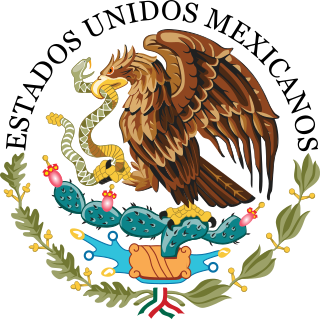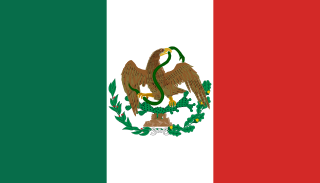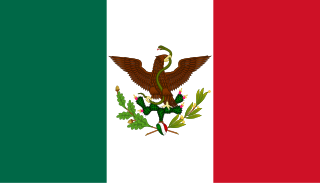
Federalism is the mixed or compound mode of government, combining a general government with regional governments in a single political system. Its distinctive feature, exemplified in the founding example of modern federalism by the United States under the Constitution of 1787, is a relationship of parity between the two levels of government established. It can thus be defined as a form of government in which there is a division of powers between two levels of government of equal status.

The Politics of Mexico take place in a framework of a federal presidential representative democratic republic whose government is based on a congressional system, whereby the President of Mexico is both head of state and head of government, and of a multi-party system. The federal government represents the United Mexican States and is divided into three branches: executive, legislative and judicial, Anahis term as established by the Political Constitution of the United Mexican States, published in 1917. The constituent states of the federation must also have a republican form of government based on a congressional system as established by their respective constitutions.

The federal government of Nigeria is composed of three distinct branches: legislative, executive, and judicial, whose powers are vested by the Constitution of Nigeria in the National Assembly, the President, and the federal courts, including the Supreme Court, respectively.
The separation of powers is a model for the governance of a state. Under this model, a state's government is divided into branches, each with separate and independent powers and areas of responsibility so that the powers of one branch are not in conflict with the powers associated with the other branches. The typical division is into three branches: a legislature, an executive, and a judiciary, which is the trias politica model. It can be contrasted with the fusion of powers in some parliamentary systems where the executive and legislative branches overlap.
The judiciary is the system of courts that interprets and applies the law in a country, or an international community. The first legal systems of the world were set up to prevent citizens to settle conflicts with violence.

The United Mexican States is a federal republic composed of 31 states and the capital, Mexico City, an autonomous entity.

The Federal Government of the United States is the national government of the United States, a federal republic in North America, composed of 50 states, a federal district, five major self-governing territories, and several island possessions. The federal government is composed of three distinct branches: legislative, executive, and judicial, whose powers are vested by the U.S. Constitution in the Congress, the President, and the federal courts, respectively. The powers and duties of these branches are further defined by acts of congress, including the creation of executive departments and courts inferior to the Supreme Court.

Separation of powers is a political doctrine originating in the writings of Charles de Secondat, Baron de Montesquieu in The Spirit of the Laws, in which he argued for a constitutional government with three separate branches, each of which would have defined abilities to check the powers of the others. This philosophy heavily influenced the writing of the United States Constitution, according to which the Legislative, Executive, and Judicial branches of the United States government are kept distinct in order to prevent abuse of power. This United States form of separation of powers is associated with a system of checks and balances.

State governments of the United States are institutional units in the United States exercising some of the functions of government at a level below that of the federal government. Each state's government holds legislative, executive, and judicial authority over a defined geographic territory. The United States comprises 50 states: 13 that were already part of the United States at the time the present Constitution took effect in 1789, plus 37 that have been admitted since by Congress as authorized under Article IV, Section 3 of the Constitution.

In the United States, a state is a constituent political entity, of which there are currently 50. Bound together in a political union, each state holds governmental jurisdiction over a separate and defined geographic territory and shares its sovereignty with the federal government. Due to this shared sovereignty, Americans are citizens both of the federal republic and of the state in which they reside. State citizenship and residency are flexible, and no government approval is required to move between states, except for persons restricted by certain types of court orders. Four states use the term commonwealth rather than state in their full official names.
Judicial review is a process under which executive or legislative actions are subject to review by the judiciary. A court with authority for judicial review may invalidate laws acts and governmental actions that are incompatible with a higher authority: an executive decision may be invalidated for being unlawful or a statute may be invalidated for violating the terms of a constitution. Judicial review is one of the checks and balances in the separation of powers: the power of the judiciary to supervise the legislative and executive branches when the latter exceed their authority. The doctrine varies between jurisdictions, so the procedure and scope of judicial review may differ between and within countries.

State governments of Mexico are those sovereign governments formed in each Mexican state.

The Federal government of Mexico is the national government of the United Mexican States, the central government established by its constitution to share sovereignty over the republic with the governments of the 31 individual Mexican states, and to represent such governments before international bodies such as the United Nations. The Mexican federal government has three branches: executive, legislative, and judicial and functions per the Constitution of the United Mexican States, as enacted in 1917, and as amended.

The Constitution of Apatzingán, was promulgated on October 22, 1814, by the Congress of Anahuac gathered in the city of Apatzingán because of the persecution of the troops of Félix María Calleja. The Constitution was valid for insurgent forces in the territories where it gained control during the Mexican War of Independence.

The Provisional Government of Mexico, was an organization denominated Supreme Executive Power which served as Executive to govern México between 1823 and 1824, after the fall of the Mexican Empire of Agustín I. The organization was responsible for convening the creation of a Federal Republic, the United Mexican States and was in effect from April 1, 1823 to October 10, 1824.

The Second Federal Republic of Mexico is the name given to the second attempt to achieve a federalist government in Mexico. Officially called the United Mexican States, a federal republic was implemented again on August 22, 1846 when interim president José Mariano Salas issued a decree restoring the 1824 constitution. Like the Mexican Empire, the First Federal Republic and the Centralist Republic it was a chaotic period, marked by political instability that resulted in several internal conflicts. Mexico's loss of the war with the United States saw half the territory Mexico claimed become part of the United States. Even though Antonio López de Santa Anna played a major role in much of this history, he returned to the presidency yet again, selling northern territory coveted by the United States contiguous to territory it just gained in the Treaty of Guadalupe Hidalgo. The sale of the Mesilla Valley was for many the final straw, and liberals promulgated of the Plan of Ayutla, calling for the overthrow of Santa Anna. Santa Anna went into exile and the liberals set about implementing their vision of Mexico.

Miguel Basáñez Ebergenyi is a former ambassador of Mexico to the United States. Prior to his appointment as ambassador, Basáñez was an academic who taught classes at the Fletcher School of Law and Diplomacy at Tufts University.


















